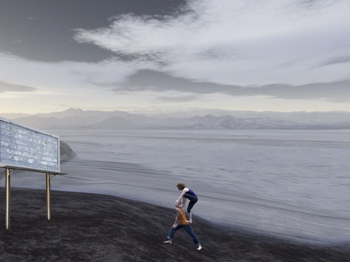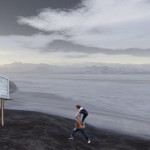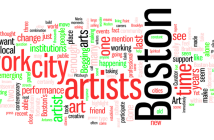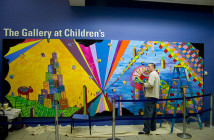Note: This piece is the second in a series of interviews by Christian Holland with the four 2006 finalists for the ICA prize. You can read his interview with finalist Kelly Sherman here. Look for more interviews in future issues.
Christian Holland: What does the ICA prize mean for you as an individual and an artist?
Jane D. Marsching: It’s great; I was shocked and delighted. Not only because it’s great to be appreciated, but because this is a great moment to do the prize. For me it was the international exposure that I could get. I don’t actually show that much in Boston. It’s a small city, everybody feels like they’re within reach here, but then there’s bigger leap to thinking about Helsinki or Berlin or other cities I’m interested in, particularly, Northern European cities because I’m doing this project on the arctic. In Scandinavia there’s a lot of real interest in this kind of work; and in Finland there’s a huge New Media community.
CH: Do you think there’s a shift between this year’s four finalists and previous winners in their medium? Or, in their careers?
JDM: Kanishka [Raja] was the last person…
CH: And you see advertisements for his shows in Art Forum and things like that…
JDM: …And he’s moved to New York and he’s a painter and painters can have great careers in a different kind of a way. But anyway, yeah absolutely, Layla Ali moved to New York and has a huge career. I feel like when Kanishka got the prize, it was just as he was making that leap and the same with Layla Ali. I think for a lot of people, it seems like this prize has been the thing that has come right on the cusp of them doing something -- like for Taylor [Davis] it was just before she was in the Whitney Biennial. I don’t know if this functioned for them as a stepping stone -- their work was taking off and it was multiply recognized at the same time. So I feel like the careers of some of the artists who are in the show this year are not too dissimilar from some of those people.
CH: What has being a finalist done for you career-wise? How will it help you or change anything?
JDM: I think I’ve had a really good year; there’s something about [my project for the ICA show], maybe because it’s about climate change and sustainability issues, but people seem to be interested in it. I got a Creative Capital grant, a LEF grant and an Artist Trust grant this year; it just seems to be a good year. (She knocks on the wooden table.) I should knock for the rest of the day.
CH: If you were to win the prize, what to you think you next step would be?
JDM: Well if I win the prize Sheila Gallagher and I are going to Costa Rica on a Yoga Retreat. You can print that. (laughs) And if she wins we’re also going to Costa Rica on a yoga retreat. So we feel like our chances of winning have radically increased.
CH: You both have a 50-50 chance of going to Costa Rica.
JDM: That’s right, having something super fantastic happen.
I actually think it would be really great if Kelly [Sherman] or Rachel [Perry Welty] get it as well. I have such respect for the other artists; I think they are all really amazing women, but Sheila and I are close friends and have been for a while. We share a lot of interest in our work so it’s been really nice to have my comrade go through the process over the past year.
CH: What does the recognition mean to you? Boston’s worried that you are all going to leave.
JDM: Well, I’m not going anywhere. My husband’s a musician in “Blue Man Group” and Sheila’s husband is an architect and has his own firm here, but I think Kelly’s moving to New York City, but I don’t know about Rachel. But she’s having a show at the Drawing Center, isn’t that great?
I think Boston has a great art scene. I moved here from New York thinking I was moving to the provincial backwater of the world, because I was such a total New York centric snot. And after six months I sort of looked around and thought, ‘huh. There seems to be some interesting artists here.’ So I went to open studios at the Distillery and Fort Point and I looked at people’s work and I spied on them to see if they looked like cool people and I invited 12 people to be in an artist group. Deb Todd Wheeler was one of them who has a great show at Green Street Gallery now.
CH: Do you think that the art scene in Boston is competitive? In the same way as New York City?
JDM: Well, I got my grad degree in New York at SVA and I think it’s really differently competitive here. It’s competitive, of course; only a certain small group of people can sell work to a certain small collector base or show work here. Because the market is so much smaller here and because there’s this feeling of being outside the art scenes in the world, I think artists have a lot more freedom to develop in the way they want to develop and say no to what they want to say no to; to have priorities outside of the market economy; to be weird and screwed up. I think it’s harder when you’re in New York. The ambition to be a success and what success means in New York is a much greater burden, I think, than it is here. I would be a really different artist if I stayed in New York.
CH: Does something like the new format for the ICA prize change the market in Boston? I think of the market in Boston as something different, it’s a different animal.
JDM: It is, isn’t it? I was talking about this to a dealer in New York over the summer, and she was saying to me that it is true, of course, but she was saying that the buzz about artists still comes from artists. I was really amazed by that. Ellen Driscoll, who’s been a Boston artist but has a studio in New York too, once said to me that artists rise like the tide rises. They sort of all bring each other together, and I think that’s true in Boston. I thought it was less true in New York, but this dealer was really making a big claim that it’s still really true there too. It feels like it’s more behind the scenes because it’s cloaked by the huge quantity of money that the Dana Schutz's make.
CH: Do you see you being a finalist as a shift in what the ICA has focused on in the past?
JDM: Not hugely. It seems to me from the 10 years that I’ve been in Boston that they’ve shown such a really huge range, like Carsten Holler’s slide, to video installation. I will say that I think they have not shown a lot of new media work at the ICA. It’s not been a really strong focus of theirs, like a lot of institutions in the country. I’m showing a net art piece as part of this show and I think it might be one of the first they’ve shown.
The jury is not ICA people, except Jill Medvedow. It must be funny for them to have this show, that’s “The ICA” and all these artists represent the ICA, but other curators/artists pick them. I’d be curious to know what they think of that.
CH: Do you think it’s strange that, though there are four nominees this year, they are all the same gender.
JDM: I think women should take over the world and it’s about time.
CH: Can I print that?
JDM: mmmhm
CH: Is that all?
JDM: No, I think there are amazing women artists in Boston; there are also amazing male artists, but there are a LOT of great women artists. I’ve always been a person who’s had a very strong community of women artists and feel like that’s a huge part of the Boston art scene and so it didn’t surprise me.
I wonder if you went back through past winners what the percentage would be. It just seems like a lot of women have won the prize, period. And maybe that says something there, just statistically, about Boston’s art scene.
CH: I agree with you; there seems to be more women in the Boston art scene.
JDM: Why do you think that is, I mean, it’s certainly not true in New York; statistically, we know that from the Guerilla Girls. Somebody should do a project about that, a Boston Guerilla Girls project where they statistically analyze it and figure it out. It’d be good to know.
CH: Can you tell me a little bit about your work in the show?
JDM: It’s all collaborative, interdisciplinary, sort-of, hybrid art-research work. So every piece is -- I like Pierre Huyghe’s term, the 'aesthetic of alliances' as opposed to ‘collaborative’ because I think collaborative suggests one kind of relationship in art making which is not all what this work represents. Every piece has those alliances with other individuals who contribute to it in different ways and whose conversations contribute to it in different ways.
The prints I am showing are results of conversations with glaciologists from around the world who are part of a group called Glaciodyn who are studying the dynamic response of the mass balance of glaciers to environmental factors, i.e. climate change. And so they give me their digital elevation models of the glaciers. I then render those in a 3D rendering program called Teragon, a landscape visualization program and wrap them with temperature, snow cover or light—sensitive data. It’s not really accurate, per se, but it’s approximating what’s really in a space for a certain time of year.
And them I’m doing this online piece called Climate Commons with Mathew Shanley, which is basically a mutli-author blog where 12 people contribute their research about climate change, sustainability and the arctic. The only thing that makes it sufficiently different from a regular blog is that the comments page is a hexagram hive visual structure so you can join the conversation wherever you want instead of being stuck in the kind of chronology of postings that are so dull. And that piece you can see at home or you can see at the ICA on these tables that I made with Chris Wawrinofsky and Justin Knapp which are modular social spaces for viewing the net-art piece and made from materials upcycled from the dumpsters of the current ICA building.
CH: How much of your art is about informing the public or engaging them with the subject of your works? The case here, being climate change.
JDM: An increasingly bigger and bigger part of the work. I read this great book by Grant Kester called Conversation Pieces, it’s a really beautiful book about art and oppositionality and just thinking about the role of art in activism in the art world and how many people vie away from having anything to do with that but I think art is political. I love when people step right up on a soap box and proclaim what they believe and try to engage other people in provocative conversation.
This Climate Commons piece is very much the pivotal piece of my show at the ICA. It has an audience completely outside the ICA; the green blogosphere will be much more interested in it than your average ICA viewer, I’m speculating. It’s really entirely about creating a conversation around these issues like a dinner table conversation with a thousand people. My role in that is really minor.
CH: What do you think of the other artists you’ve been nominated with?
JDM: I think they’re wonderful. I feel like, having nothing to do with me in it, if it was a show of three, I’d think, “Wow, that’s a really great group of people that they picked.” I think they’re all similar in a certain kind of way, but they’re all enormously different artists all fiercely independent women who are doing what they need to do.
CH: Who are your favorite Boston artists?
JDM: Deb Todd Wheeler, super fantastic. Sheila Gallagher, absolutely. Who else? Ellen Driscoll. Jill Slosberg-Ackermam. I just met Maria Magdalena Campos-Pons the other night and I’ve really always loved her work. And these are all women, I’m noticing as I’m saying them. Laura McPhee; her show was beautiful. Taylor Davis. I’m going to stop there. But I could go on and on.
CH: I was waiting for you to say someone who wasn’t female. I’m glad we talked about the lack of male artists in the group of finalists.
JDM: Yeah, you should get all of us to talk about it. Don’t you think? It’s a really great question. “Why do you think they’re all women, and what’s going on with that?” If you could imagine a show with four men, who would they be?
Links:
Jane D. Marsching
The James and Audrey Foster Prize exhibition is on view December 10, 2006 through March 11, 2007 at The Institute of Contemporary Art/Boston.
Read Christian Holland's article in Issue 44 on ICA prize finalist Kelly Sherman.
Image courtesy of the artist.
Jane D. Marsching is a Boston based new media artist. In 2006 she received a Creative Capital grant, an Artists Resource Trust grant, and a LEF Foundation Contemporary Work Fund grant both for her project Arctic Listening Post. She has curated exhibitions including (with Mark Alice Durant) "The Blur of the Otherworldly: Technology and the Paranormal" at the CVAC at UMBC, and writes essays on art and technology including an essay in the catalog she coedited with "Durant The Blur of the Otherworldly". She is currently Assistant Professor at Massachusetts College of Art in Studio Foundation. She received her MFA in photography from The School of Visual Arts in 1995.




